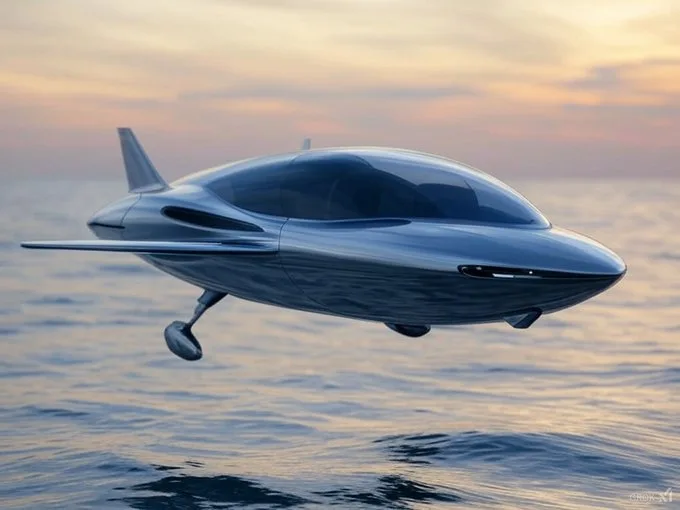IIT M Startup : Imagine covering the 1,600 km distance between Chennai and Kolkata in just three hours, and that too for a mere Rs 600! This futuristic travel claim comes from Waterfly Technologies, an IIT-Madras incubated startup that is working on electric seagliders using Wing-in-Ground (WIG) technology. The company made this ambitious revelation at Aero India 2025, setting the stage for a revolution in affordable and high-speed travel.
IIT M Startup : Chennai to Kolkata in 3 Hours for Just Rs 600? IIT-M Backed Startup Claims It’s Possible!
Table of Contents
How Will It Work?
Waterfly Technologies is banking on Wing-in-Ground (WIG) effect seagliders, which are designed to take off from water and fly at a height of approximately four meters above the surface. This unique technology leverages the ground effect to significantly reduce drag and increase fuel efficiency, making it far cheaper than traditional air travel.
Co-founder Keshav Choudhary explained the science behind the idea:
“We fly very close to the water’s surface and take advantage of a physical phenomenon called ground effect. This reduces drag as the wing tip vortices get obstructed by the surface. Additionally, flying close to the surface creates an air cushion that increases lift, allowing us to travel at lower speeds while still carrying passengers.”
With these efficiency-boosting factors, the company claims that their craft will have 10 times better fuel efficiency than a standard aircraft.
Comparing Costs: WIG Seaglider vs Traditional Transport
A Chennai-Kolkata flight in a Boeing 737 or Airbus A320 currently consumes 2.5 to 3 tonnes of Aviation Turbine Fuel, costing nearly Rs 95,000 per kiloliter. In comparison, Waterfly Technologies’ seaglider will be significantly more energy-efficient and cost-effective.
Here’s a cost breakdown for perspective:
| Mode of Transport | Travel Time | Ticket Cost |
|---|---|---|
| WIG Seaglider (Waterfly) | 3 Hours | Rs 600 |
| Flight (Airbus/Boeing) | 2.5 Hours | Rs 3,500 – 5,000 |
| AC 3-Tier Train | 26-28 Hours | Rs 1,500 |
With ticket pricing as low as Rs 600 per passenger, this mode of transport will be even cheaper than an AC 3-tier train ticket, making it a game-changer for budget-conscious travelers.
Why Are These Seagliders So Cheap to Build?
Apart from efficiency, Waterfly Technologies has also designed the seagliders to be cheaper to manufacture compared to traditional airplanes. Since they fly at a low altitude, they don’t require high-pressure cabins, eliminating the need for costly mechanical reinforcements.
“We don’t have to deal with high mechanical stress like normal airplanes. This significantly reduces manufacturing costs,” Choudhary added.
Another cost-cutting advantage is the design of the engines. Unlike conventional aircraft, WIG crafts don’t need powerful engines to climb to high altitudes or sustain takeoff in case of an engine failure. Since they operate on water, they can make use of its “infinite runway,” eliminating the need for extensive thrust power.
What’s Next? The Roadmap Ahead
At Aero India 2025, Waterfly Technologies showcased only the initial designs of the seaglider. Here’s their roadmap for implementation:
- April 2025 – Build and test a 100 kg prototype
- Late 2025 – Develop a one-tonne prototype
- 2026 – Launch a 20-seater full-scale version
- 2029 – Target international routes like Chennai-Singapore and Dubai-Los Angeles
Potential Challenges & Funding Support
While the project is promising, it is still in the early stages. The startup has received grants from IIT Madras and is looking for additional funding, including support from defense organizations. They are also exploring cargo transportation and surveillance applications for their WIG crafts.
One of the biggest challenges they face is regulatory approval, as this is a new mode of transport that will require compliance with aviation and maritime authorities.
A Revolutionary Step in Travel?
Waterfly Technologies’ ambitious project could disrupt the travel industry, offering an ultra-affordable and fast alternative to conventional air and train travel. If they succeed in delivering on their promises, Rs 600 for a 3-hour Chennai-Kolkata trip could soon become a reality.
FAQs
How does the WIG seaglider work?
It flies close to the water’s surface, using the ground effect to reduce drag and improve fuel efficiency.
How much will the ticket cost for a Chennai-Kolkata trip?
The estimated ticket price is just Rs 600 per passenger.








